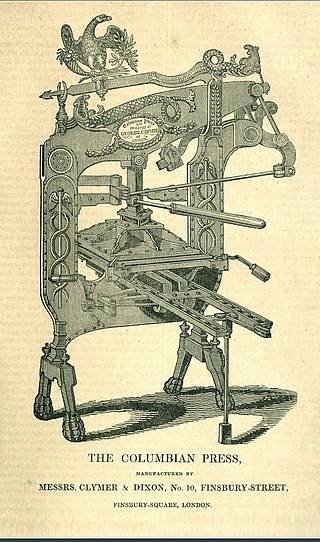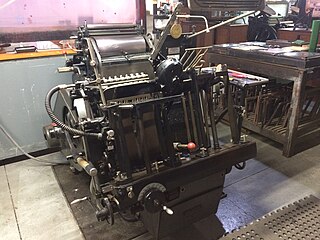
Lithography is a planographic method of printing originally based on the immiscibility of oil and water. The printing is from a stone or a metal plate with a smooth surface. It was invented in 1796 by the German author and actor Alois Senefelder and was initially used mostly for musical scores and maps. Lithography can be used to print text or images onto paper or other suitable material. A lithograph is something printed by lithography, but this term is only used for fine art prints and some other, mostly older, types of printed matter, not for those made by modern commercial lithography.

Printing is a process for mass reproducing text and images using a master form or template. The earliest non-paper products involving printing include cylinder seals and objects such as the Cyrus Cylinder and the Cylinders of Nabonidus. The earliest known form of printing evolved from ink rubbings made on paper or cloth from texts on stone tablets, used during the sixth century. Printing by pressing an inked image onto paper appeared later that century. Later developments in printing technology include the movable type invented by Bi Sheng around 1040 AD and the printing press invented by Johannes Gutenberg in the 15th century. The technology of printing played a key role in the development of the Renaissance and the Scientific Revolution and laid the material basis for the modern knowledge-based economy and the spread of learning to the masses.

George E. Clymer, printing press inventor and manufacturer, from Philadelphia, Pennsylvania, was an American engineer and all around inventor. Clymer, in his earlier vocational years, was something of a civil engineer and as an inventor became noted for his improvements and developments in early nineteenth century printing presses, and ultimately developed his own distinctive printing press, which soon became widely known as the Columbian Printing Press, which were often favorably received by printers in America, England and parts of Europe. After relocating to England because of better market conditions, Clymer subsequently became one of the principal developers and suppliers of printing presses in Europe in the early nineteenth century. The innovative designs he incorporated into his printing presses were put to use in the manufacturing of other printing presses years after his death.

Print on demand (POD) is a printing technology and business process in which book copies are not printed until the company receives an order, allowing prints in single or small quantities. While other industries established the build-to-order business model, POD could only develop after the beginning of digital printing because it was not economical to print single copies using traditional printing technologies such as letterpress and offset printing.

Offset printing is a common printing technique in which the inked image is transferred from a plate to a rubber blanket and then to the printing surface. When used in combination with the lithographic process, which is based on the repulsion of oil and water, the offset technique employs a flat (planographic) image carrier. Ink rollers transfer ink to the image areas of the image carrier, while a water roller applies a water-based film to the non-image areas.

Letterpress printing is a technique of relief printing for producing many copies by repeated direct impression of an inked, raised surface against individual sheets of paper or a continuous roll of paper. A worker composes and locks movable type into the "bed" or "chase" of a press, inks it, and presses paper against it to transfer the ink from the type, which creates an impression on the paper.

American Type Founders (ATF) Co. was a business trust created in 1892 by the merger of 23 type foundries, representing about 85 percent of all type manufactured in the United States at the time. The new company, consisting of a consolidation of firms from throughout the United States, was incorporated in New Jersey.
StyleWriter is a line of inkjet serial printers by Apple, targeted mainly towards consumers. They produced print quality that was better than the dot matrix ImageWriters, and were cheaper than the LaserWriters. All but a few models contained Canon print engines, while the last few were re-badged HP Deskjet printers. When Steve Jobs returned to Apple in 1997, he discontinued most of the company's accessory product lines, including the StyleWriter and LaserWriter.
A platen is a flat platform with a variety of roles in printing or manufacturing. It can be a flat metal plate pressed against a medium to cause an impression in letterpress printing. Platen may also refer to a typewriter roller which friction-feeds paper into position below the typebars or print head. It can refer to the glass surface of a copier, and the rotating disk used to polish semiconductor wafers.
Purnell and Sons started out as a small family printers based in Somerset which merged with other printers over the next 100 years to become one of the largest print groups in the UK and at one time a major publisher.

Vivian Hughes Ridler, CBE, was a printer, typographer and scholar in Britain. He was Printer to the University of Oxford at Oxford University Press from 1958 until his retirement in 1978; and also established his own Perpetua Press.

Heidelberger Druckmaschinen AG is a German precision mechanical engineering company with registered offices in Heidelberg (Baden-Württemberg) and headquarters in Wiesloch/Walldorf (Baden-Württemberg). The company offers product and services along the entire process and value chain for printing products and is the largest global manufacturer of offset printing presses. Sheet-fed offset printing is used predominantly for high-quality, multi-colour products, such as catalogues, calendars, posters, and labels. Heidelberg produces equipment for prepress, press and postpress.

A jobbing press, job press, or jobber is a variety of printing press used in letterpress printing.
Vandercook & Sons was a manufacturer of proof presses, founded in 1909 by Robert Vandercook. They dominated the 20th century proof press industry by developing the first and the most widely used proof presses that did not rely on gravity for the force of their impression. As a result, Vandercook's geared presses were easier and more precise for an operator to use.

Adana Printing Machines were manufactured from 1922 to 1999 in Twickenham, England. Although most of the printing presses produced by Adana were aimed at hobby printers, they were frequently put to commercial use. Adanas are still to be found throughout the world in the hands of colleges, enthusiasts and professional printers. Caslon Limited manufactured machines after a takeover of the company in 1987.

The Ben Lane Print Shop is a demonstration site at Shelburne Museum in Shelburne, Vermont, in the United States.
Brandtjen and Kluge is a US manufacturer of platen foil stamping, embossing & diecutting presses along with modular folder-gluers. Together John and Henry Brandtjen and the Kluge brothers developed the world's first successful automatic feeder for open platen (Gordon) printing presses, and in November 1919, Brandtjen & Kluge was formed in St. Paul, Minnesota to manufacture and sell the feeder. Brandtjen & Kluge is currently located in St. Croix Falls, Wisconsin.

Harrild & Sons Limited is a defunct British manufacturer of printing machinery and supplies. The company was founded in 1809 by Robert Harrild at Norwich Street, London, and closed down in 1949. The company helped to establish the use in London of composition rollers instead of ink balls to ink the printing plates.

The Original Heidelberg Platen Press was a letterpress printing press manufactured by the Heidelberger Druckmaschinen company in Germany. It was often referred to as the Heidelberg Windmill, after the shape and movement of its paper feed system. When introduced, it was also called the "Super Heidelberg" or the "Super Speed".
The Penrith Museum of Printing is a museum in Penrith, New South Wales, Australia with a focus on Australian letterpress printing equipment and techniques.
















